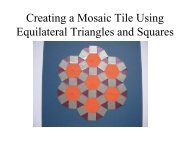OxfOrd flOrence in - Museum of the History of Science
OxfOrd flOrence in - Museum of the History of Science
OxfOrd flOrence in - Museum of the History of Science
Create successful ePaper yourself
Turn your PDF publications into a flip-book with our unique Google optimized e-Paper software.
Sundial and Qibla <strong>in</strong>dicator<br />
Times <strong>of</strong> prayer and <strong>the</strong> sacred direction for pray<strong>in</strong>g<br />
– towards Mecca – are important elements <strong>of</strong><br />
Islamic observance and <strong>the</strong> astronomical and<br />
geometrical challenges <strong>the</strong>y present have given<br />
rise to a variety <strong>of</strong> <strong>in</strong>genious <strong>in</strong>struments. This<br />
one comb<strong>in</strong>es a sundial and a ‘Qibla <strong>in</strong>dicator’<br />
(for direction). The horizontal p<strong>in</strong>-gnomon dial is<br />
on <strong>the</strong> upper section <strong>of</strong> <strong>the</strong> plate (see left-hand<br />
illustration) and would have <strong>in</strong>dicated <strong>the</strong> time<br />
<strong>in</strong> ‘Babylonian hours’, i.e. counted from sunrise,<br />
but <strong>the</strong> h<strong>in</strong>ged gnomon for cast<strong>in</strong>g <strong>the</strong> shadow<br />
is miss<strong>in</strong>g, as is <strong>the</strong> magnetic compass that<br />
was set <strong>in</strong> <strong>the</strong> circular hole. The lower section<br />
<strong>of</strong> <strong>the</strong> plate, though now <strong>in</strong>complete, was used<br />
to f<strong>in</strong>d <strong>the</strong> Qibla, <strong>in</strong> comb<strong>in</strong>ation with a table <strong>of</strong><br />
geographical data on various places engraved on<br />
<strong>the</strong> reverse (see right). This Persian <strong>in</strong>strument is<br />
unsigned but dates from <strong>the</strong> eighteenth century.<br />
BROAD SHEET communicates <strong>the</strong> work <strong>of</strong> <strong>the</strong><br />
<strong>Museum</strong> <strong>of</strong> <strong>the</strong> <strong>History</strong> <strong>of</strong> <strong>Science</strong>, Oxford.<br />
It is posted on <strong>the</strong> <strong>Museum</strong>’s website,<br />
sold <strong>in</strong> <strong>the</strong> shop, and distributed to members<br />
<strong>of</strong> <strong>the</strong> mail<strong>in</strong>g list, see www.mhs.ox.ac.uk.<br />
Broad Sheet is produced by <strong>the</strong><br />
<strong>Museum</strong> <strong>of</strong> <strong>the</strong> <strong>History</strong> <strong>of</strong> <strong>Science</strong>, Oxford<br />
Broad Street, Oxford OX1 3AZ<br />
Tel +44(0)1865 277280 Fax +44(0)1865 277288<br />
Web: www.mhs.ox.ac.uk<br />
Email: museum@mhs.ox.ac.uk<br />
No.8<br />
Inventory no. 48472<br />
£1.00<br />
Sundials<br />
Oxford<br />
<strong>in</strong><br />
Florence<br />
Roman portable sundial<br />
A rare example <strong>of</strong> <strong>the</strong> t<strong>in</strong>y number <strong>of</strong><br />
surviv<strong>in</strong>g portable sundials from <strong>the</strong><br />
Roman era. There are two discs, <strong>the</strong><br />
smaller turn<strong>in</strong>g <strong>in</strong> a central recess <strong>in</strong><br />
<strong>the</strong> larger. This adjustment allows<br />
<strong>the</strong> <strong>in</strong>strument to be set for a range <strong>of</strong><br />
latitudes, accord<strong>in</strong>g to a scale on <strong>the</strong><br />
larger disc marked ‘XXX’ - ‘LX’. The<br />
curved piece which rotates above <strong>the</strong><br />
smaller disc is a comb<strong>in</strong>ed hour scale<br />
and gnomon (<strong>the</strong> part <strong>of</strong> a sundial<br />
that casts <strong>the</strong> shadow). This is set<br />
for date (solar decl<strong>in</strong>ation) aga<strong>in</strong>st<br />
a scale on <strong>the</strong> smaller disc, rang<strong>in</strong>g<br />
from ‘VIII K IAN’ (=25th December)<br />
for <strong>the</strong> w<strong>in</strong>ter solstice to ‘VIII K IVL’<br />
(=24th June) for <strong>the</strong> summer solstice<br />
<strong>in</strong> <strong>the</strong> Julian calendar. Once <strong>the</strong>se<br />
adjustments have been made, <strong>the</strong><br />
dial can be suspended vertically<br />
and turned until <strong>the</strong> shadow <strong>of</strong> <strong>the</strong><br />
gnomon falls on <strong>the</strong> curved hourscale,<br />
<strong>in</strong>dicat<strong>in</strong>g <strong>the</strong> time. On <strong>the</strong><br />
back <strong>of</strong> <strong>the</strong> large disc are engraved<br />
<strong>the</strong> latitudes, given <strong>in</strong> degrees, <strong>of</strong> 30<br />
prov<strong>in</strong>ces <strong>of</strong> <strong>the</strong> Roman Empire. For<br />
nearly every prov<strong>in</strong>ce, <strong>the</strong> latitude<br />
cited is <strong>the</strong> mean <strong>of</strong> <strong>the</strong> range <strong>of</strong><br />
latitudes given for that prov<strong>in</strong>ce by<br />
Ptolemy. The dial is thought to date<br />
from <strong>the</strong> 3rd century A.D. but <strong>the</strong><br />
maker is not known.<br />
Inventory no. 51358<br />
The 400th anniversary <strong>of</strong><br />
Galileo’s telescopic discoveries<br />
The <strong>Museum</strong> <strong>of</strong> <strong>the</strong> <strong>History</strong> <strong>of</strong> <strong>Science</strong> is lend<strong>in</strong>g some<br />
<strong>of</strong> its most famous <strong>in</strong>struments to a special exhibition<br />
to be held <strong>in</strong> Florence from 13 March till 30 August<br />
2009, ‘Galileo. Images <strong>of</strong> <strong>the</strong> Universe from Antiquity<br />
to <strong>the</strong> Telescope’. The <strong>in</strong>struments <strong>in</strong>clude unique<br />
items closely associated with <strong>the</strong> <strong>Museum</strong>, such as<br />
<strong>the</strong> ‘spherical astrolabe’ and <strong>the</strong> ‘geared astrolabe’.<br />
We apologise that <strong>the</strong>y will be gone dur<strong>in</strong>g <strong>the</strong><br />
summer months, when we have many visitors, but <strong>the</strong><br />
anniversary <strong>of</strong> Galileo’s work is an <strong>in</strong>ternational event<br />
whose focus is properly located <strong>in</strong> Florence, and items<br />
from our <strong>in</strong>ternational collection should contribute<br />
to <strong>the</strong> celebration. The exhibition is organised by <strong>the</strong><br />
Fondazione Palazzo Strozzi and <strong>the</strong> Istituto e Museo<br />
di Storia della Scienza, is curated by Pr<strong>of</strong>essor Paolo<br />
Galluzzi, and will be held <strong>in</strong> <strong>the</strong> Palazzo Strozzi (www.<br />
palazzostrozzi.org). This issue <strong>of</strong> Broadsheet deals<br />
with <strong>the</strong> <strong>in</strong>struments <strong>in</strong> Florence that are normally<br />
on display here. One side has <strong>in</strong>struments applied to<br />
astronomical calculations; on <strong>the</strong> o<strong>the</strong>r <strong>the</strong>y are used<br />
as representations <strong>of</strong> <strong>the</strong> heavens.<br />
Image credit: ech<strong>in</strong>er1 on Flickr (www.flickr.com/photos/30567804@N00/583616150), Creative Commons license.<br />
Spherical Astrolabe<br />
The Spherical Astrolabe<br />
Astrolabes generally present <strong>the</strong> stars and <strong>the</strong> path<br />
<strong>of</strong> <strong>the</strong> sun on a flat surface us<strong>in</strong>g a planispheric<br />
projection, <strong>in</strong> <strong>the</strong> manner <strong>of</strong> a map <strong>of</strong> <strong>the</strong> world.<br />
This is <strong>the</strong> only complete example <strong>of</strong> a spherical<br />
astrolabe, where <strong>the</strong> heavens reta<strong>in</strong> <strong>the</strong> spherical<br />
form <strong>the</strong>y are assumed to have <strong>in</strong> traditional<br />
astronomy. The solid sphere carries co-ord<strong>in</strong>ate<br />
l<strong>in</strong>es based on <strong>the</strong> horizon, while <strong>the</strong> bands that<br />
enclose it, form<strong>in</strong>g a ‘rete’ or net, <strong>in</strong>corporate<br />
circles for <strong>the</strong> equator and <strong>the</strong> ecliptic (<strong>the</strong> path<br />
<strong>of</strong> <strong>the</strong> sun) and carry po<strong>in</strong>ters for <strong>the</strong> positions <strong>of</strong><br />
prom<strong>in</strong>ent stars.<br />
The spherical astrolabe is used for <strong>the</strong> same set<br />
<strong>of</strong> astronomical calculations as <strong>the</strong> more common<br />
planispheric model but is less convenient to use<br />
and less robust. It is thought to be an Islamic<br />
<strong>in</strong>vention and <strong>the</strong>re are treatises on <strong>the</strong> <strong>in</strong>strument<br />
by an-Nairīzī (d. c.922) and al-Bīrūnī (973-1048).<br />
The <strong>in</strong>strument is signed ‘Work <strong>of</strong> Mūsa. Year 885 [ =<br />
A.D. 1480/1]’ and from <strong>the</strong> style <strong>of</strong> letter<strong>in</strong>g and <strong>the</strong><br />
system <strong>of</strong> numerals used, it is understood to have<br />
been made <strong>in</strong> Eastern Islam. The sphere is <strong>of</strong> brass<br />
with <strong>in</strong>scriptions and engraved l<strong>in</strong>es damascened<br />
<strong>in</strong> silver, while <strong>the</strong> surround<strong>in</strong>g rete is <strong>of</strong> brass,<br />
lam<strong>in</strong>ated with silver on <strong>the</strong> ecliptic and equatorial<br />
circles and on <strong>the</strong> vertical quadrant; <strong>the</strong> suspension<br />
piece is <strong>of</strong> silver. The rete has po<strong>in</strong>ters for 19 fixed<br />
stars, all named and all above <strong>the</strong> ecliptic, and <strong>the</strong><br />
astrolabe can be adjusted for use <strong>in</strong> any latitude.<br />
Inventory no. 49687<br />
Geared Astrolabe<br />
Astrolabe with geared calendar<br />
This Persian astrolabe, made <strong>in</strong> Isfahan by<br />
Muhammad ibn Abī Bakr al Ibarī,<strong>in</strong> 1221/2,<br />
conta<strong>in</strong>s a geared calendar movement and is <strong>the</strong><br />
oldest geared mach<strong>in</strong>e <strong>in</strong> existence <strong>in</strong> a complete<br />
state. One side is an astrolabe and is connected<br />
to <strong>the</strong> calendar by a tra<strong>in</strong> <strong>of</strong> gears. It illustrates an<br />
important stage <strong>in</strong> <strong>the</strong> development <strong>of</strong> <strong>the</strong> various<br />
complex astronomical mach<strong>in</strong>es from which <strong>the</strong><br />
mechanical clock derives. The design is based<br />
on a text by al-Bīrūnī (973-1048), who expla<strong>in</strong>ed<br />
how a special tra<strong>in</strong> <strong>of</strong> gear<strong>in</strong>g might be used to<br />
show <strong>the</strong> revolutions <strong>of</strong> <strong>the</strong> sun and moon at <strong>the</strong>ir<br />
relative rates and to demonstrate <strong>the</strong> chang<strong>in</strong>g<br />
phase <strong>of</strong> <strong>the</strong> moon, phenomena <strong>of</strong> fundamental<br />
importance <strong>in</strong> <strong>the</strong> lunar calendar used <strong>in</strong> Islam.<br />
The wheels have teeth shaped like equilateral<br />
triangles, recall<strong>in</strong>g <strong>the</strong> teeth on <strong>the</strong> wheels <strong>in</strong> <strong>the</strong><br />
Hellenistic astronomical comput<strong>in</strong>g mach<strong>in</strong>e found<br />
<strong>in</strong> a wreck <strong>of</strong> c.80 A.D. at Antiky<strong>the</strong>ra and now <strong>in</strong><br />
<strong>the</strong> National <strong>Museum</strong>, A<strong>the</strong>ns. When assembled,<br />
<strong>the</strong> geared calendar is operated by turn<strong>in</strong>g <strong>the</strong><br />
‘rete’ <strong>of</strong> <strong>the</strong> astrolabe. One circular open<strong>in</strong>g on<br />
<strong>the</strong> back reveals a lunar phase diagram, while a<br />
rectangular open<strong>in</strong>g gives <strong>the</strong> age <strong>of</strong> <strong>the</strong> moon<br />
(and <strong>the</strong>refore <strong>the</strong> date <strong>in</strong> a lunar calendar).<br />
Below, with<strong>in</strong> a zodiacal calendar scale, are<br />
two concentric r<strong>in</strong>gs, <strong>the</strong> outer r<strong>in</strong>g <strong>in</strong>set with a<br />
small gold disc represent<strong>in</strong>g <strong>the</strong> sun, <strong>the</strong> <strong>in</strong>ner<br />
r<strong>in</strong>g formerly hav<strong>in</strong>g a similar <strong>in</strong>set represent<strong>in</strong>g<br />
<strong>the</strong> moon. The rotations <strong>of</strong> <strong>the</strong>se r<strong>in</strong>gs show <strong>the</strong><br />
relative positions <strong>of</strong> <strong>the</strong> sun and moon, and <strong>the</strong><br />
position <strong>of</strong> <strong>the</strong> sun <strong>in</strong> <strong>the</strong> zodiac.<br />
The astrolabe is made <strong>in</strong> brass and damascened<br />
with silver and gold. The highly decorated rim has<br />
pictorial representations <strong>of</strong> <strong>the</strong> signs <strong>of</strong> <strong>the</strong> zodiac,<br />
between figures <strong>of</strong> warriors. There are two plates,<br />
for use <strong>in</strong> latitudes 30° and 32°; 36° and 40°.<br />
Inventory no. 48213<br />
On one <strong>of</strong><br />
<strong>the</strong> wheels is<br />
engraved, ‘Its<br />
owner is <strong>the</strong><br />
poor man Hasan<br />
Shâh’.
Armillary Sphere<br />
Armillary Orrery<br />
Armillary Orrery<br />
Armillary Sphere<br />
Most armillary spheres follow <strong>the</strong> astronomical<br />
system <strong>of</strong> Ptolemy, with <strong>the</strong> earth<br />
stationary at <strong>the</strong> centre, while a few adopt<br />
<strong>the</strong> later Copernican arrangement, where<br />
<strong>the</strong> earth moves around <strong>the</strong> sun with <strong>the</strong><br />
o<strong>the</strong>r planets. This unique Italian armillary<br />
sphere is constructed accord<strong>in</strong>g to <strong>the</strong><br />
planetary system <strong>of</strong> Heracleides <strong>of</strong> Pontus,<br />
who lived <strong>in</strong> <strong>the</strong> 4th century B.C. Accord<strong>in</strong>g<br />
to this arrangement, Venus and Mercury<br />
revolve around <strong>the</strong> sun, while <strong>the</strong> moon,<br />
<strong>the</strong> sun, Mars, Jupiter and Saturn revolve<br />
around a central earth. In <strong>the</strong> seventeenth<br />
century this system was supported by <strong>the</strong><br />
Italian astronomer Andreas Argolus (1570-<br />
1650). Despite deal<strong>in</strong>g with such an ancient<br />
proposal, <strong>the</strong> armillary sphere is up-to-date<br />
<strong>in</strong> o<strong>the</strong>r respects. Jupiter is represented as<br />
hav<strong>in</strong>g four satellites and Saturn as hav<strong>in</strong>g<br />
three. While Galileo had discovered <strong>the</strong><br />
satellites <strong>of</strong> Jupiter, <strong>the</strong> third satellite <strong>of</strong><br />
Saturn was discovered <strong>in</strong> 1672 by Cass<strong>in</strong>i,<br />
who discovered <strong>the</strong> fourth <strong>in</strong> 1684. This<br />
suggests a date for <strong>the</strong> <strong>in</strong>strument between<br />
1672 and 1684. The horizon r<strong>in</strong>g carries <strong>the</strong><br />
name <strong>of</strong> Dom<strong>in</strong>icus Sanctes Sanct<strong>in</strong>i, who<br />
so far is not known as a maker <strong>of</strong> o<strong>the</strong>r <strong>in</strong>struments.<br />
Inventory no. 57517<br />
Richard Glynne was a maker <strong>of</strong><br />
ma<strong>the</strong>matical <strong>in</strong>struments, such as<br />
sundials and armillary spheres, who<br />
also sold maps at his shop <strong>in</strong> London,<br />
identified by <strong>the</strong> sign <strong>of</strong> ‘Atlas &<br />
Hercules’. He advertised ‘all K<strong>in</strong>ds <strong>of</strong><br />
Dials, Spheres and Globes <strong>of</strong> all Sizes.’<br />
The armillary orrery, dat<strong>in</strong>g from<br />
around 1720 and stand<strong>in</strong>g just over<br />
a metre <strong>in</strong> height, must have been at<br />
<strong>the</strong> top <strong>of</strong> his range: an impressive and<br />
expensive purchase by one <strong>of</strong> his most<br />
wealthy customers. It is an attempt<br />
to comb<strong>in</strong>e one <strong>of</strong> <strong>the</strong> oldest forms <strong>of</strong><br />
astronomical <strong>in</strong>strument, <strong>the</strong> armillary<br />
sphere, with what was <strong>the</strong>n one <strong>of</strong> <strong>the</strong><br />
most recent, <strong>the</strong> orrery or planetarium.<br />
The armillary sphere is <strong>the</strong> enclos<strong>in</strong>g<br />
outer part <strong>of</strong> <strong>the</strong> <strong>in</strong>strument, composed<br />
<strong>of</strong> r<strong>in</strong>gs represent<strong>in</strong>g <strong>the</strong> circles <strong>of</strong> <strong>the</strong><br />
celestial sphere, such as <strong>the</strong> equator,<br />
<strong>the</strong> tropics (Capricorn is miss<strong>in</strong>g)<br />
and <strong>the</strong> zodiac: it was best suited to<br />
illustrat<strong>in</strong>g <strong>the</strong> traditional Ptolemaic<br />
system with <strong>the</strong> earth stationary at <strong>the</strong><br />
centre <strong>of</strong> <strong>the</strong> cosmos and <strong>the</strong> heavens<br />
rotat<strong>in</strong>g around it. The celestial sphere<br />
rotates on an axis <strong>in</strong> this <strong>in</strong>strument<br />
but – somewhat <strong>in</strong>consistently – at<br />
<strong>the</strong> centre is a planetarium based on<br />
<strong>the</strong> Copernican system, where <strong>the</strong> sun<br />
is central and <strong>the</strong> earth both rotates on<br />
its axis daily and moves <strong>in</strong> an annual<br />
orbit. The earth and moon, Mercury<br />
and Venus are moved by wheelwork<br />
activated by a hand-crank, while<br />
Mars, Jupiter and Saturn are pushed<br />
round by hand. The drum at <strong>the</strong> north<br />
celestial pole has wheelwork mov<strong>in</strong>g<br />
<strong>the</strong> celestial sphere and a dial and<br />
hands for display<strong>in</strong>g <strong>the</strong> time.<br />
Inventory no. 57605<br />
Planetaria<br />
Pair <strong>of</strong> planetaria,<br />
Ptolemaic and Copernican<br />
Dat<strong>in</strong>g from around 1700, this is an unusual –<br />
perhaps unique – solution to <strong>the</strong> problem <strong>of</strong><br />
represent<strong>in</strong>g <strong>the</strong> cosmos by an <strong>in</strong>strument and<br />
accommodat<strong>in</strong>g both <strong>the</strong> traditional Ptolemaic<br />
arrangement, with <strong>the</strong> earth at <strong>the</strong> centre, and <strong>the</strong><br />
Copernican, where <strong>the</strong> earth is <strong>in</strong> orbit around <strong>the</strong><br />
sun, accompanied by <strong>the</strong> moon and rotat<strong>in</strong>g on<br />
its axis once a day. The two systems are treated<br />
<strong>in</strong> a pair <strong>of</strong> match<strong>in</strong>g <strong>in</strong>struments, which follow<br />
diagrams <strong>in</strong> J.C. Sturm’s Scientia Cosmica <strong>of</strong><br />
1670. Each planetarium has an outer r<strong>in</strong>g for <strong>the</strong><br />
zodiac and concentric r<strong>in</strong>gs for <strong>the</strong> planets, each<br />
carry<strong>in</strong>g a planetary symbol. S<strong>in</strong>ce <strong>the</strong> zodiac is<br />
horizontal, <strong>the</strong> earth – whe<strong>the</strong>r at <strong>the</strong> centre <strong>in</strong><br />
<strong>the</strong> Ptolemaic system or <strong>in</strong> orbit <strong>in</strong> <strong>the</strong> Copernican<br />
– is <strong>in</strong>cl<strong>in</strong>ed. The orbital r<strong>in</strong>gs, each carried by<br />
Grand Orrery<br />
Grand Orrery<br />
The partnership between Thomas Heath and his<br />
former apprentice Tycho W<strong>in</strong>g lasted from 1751<br />
to 1773, with premises at various addresses <strong>in</strong><br />
<strong>the</strong> Strand, London, and this is one <strong>of</strong> <strong>the</strong>ir most<br />
ambitious creations – a complete ‘grand orrery’<br />
with all <strong>the</strong> known planets and satellites fully<br />
driven by clockwork. The pendulum-regulated<br />
clockwork movement is beneath <strong>the</strong> base plate<br />
and it drives <strong>the</strong> planets out to Saturn with <strong>the</strong>ir<br />
respective periods, as well as <strong>the</strong> moon, four<br />
satellites <strong>of</strong> Jupiter (discovered by Galileo) and<br />
five <strong>of</strong> Saturn. The earth moves over a calendar<br />
scale giv<strong>in</strong>g <strong>the</strong> date. The glazed mahogany case<br />
is designed both to be appropriate to an elegant<br />
room and to reveal <strong>the</strong> wheelwork <strong>in</strong> addition<br />
to <strong>the</strong> planetary system – a clear sign that <strong>the</strong><br />
mechanism was meant to impress <strong>the</strong> viewer as<br />
well as <strong>the</strong> motions <strong>of</strong> <strong>the</strong> planets.<br />
Copernican Planetarium Inv. 19978<br />
Inventory no. 39896<br />
on loan from All Souls College, Oxford.<br />
four curved supports ris<strong>in</strong>g from <strong>the</strong> centre,<br />
can be rotated to represent movements and<br />
configurations <strong>of</strong> <strong>the</strong> planets; <strong>the</strong> exception<br />
is that <strong>in</strong> <strong>the</strong> Copernican <strong>in</strong>strument <strong>the</strong><br />
earth is carried by a tra<strong>in</strong> <strong>of</strong> three wheels,<br />
so that it rotates as it is moved around <strong>in</strong><br />
its orbit. In <strong>the</strong> Ptolemaic <strong>in</strong>strument <strong>the</strong><br />
symbols for Mercury and Venus, and for<br />
Saturn and Jupiter, are erroneously reversed,<br />
perhaps as <strong>the</strong> result <strong>of</strong> some subsequent<br />
repair. Although unsigned, it is likely that <strong>the</strong><br />
<strong>in</strong>struments were made <strong>in</strong> London by John<br />
Rowley.<br />
Inventory nos 68353, 19978;<br />
on loan from Christ Church, Oxford<br />
Ptolemaic Planetarium Inv. 68353


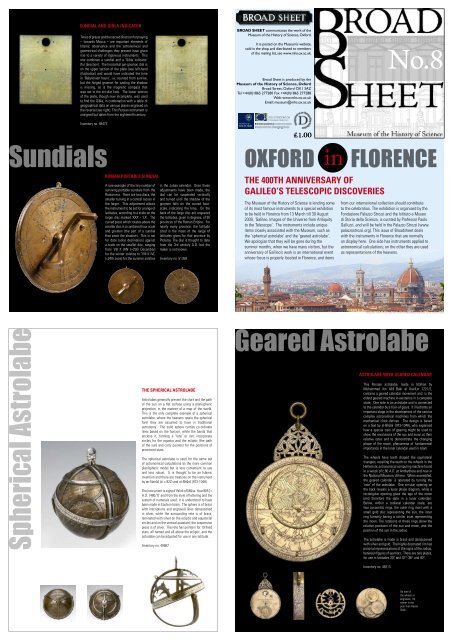
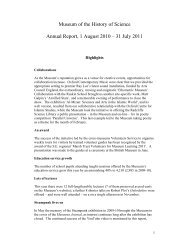
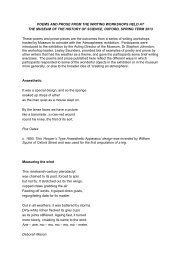
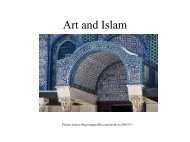
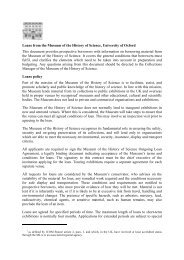
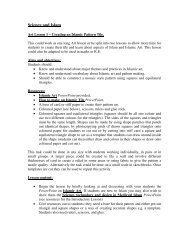
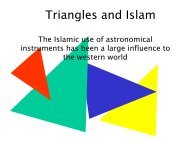
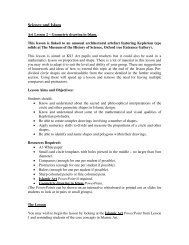
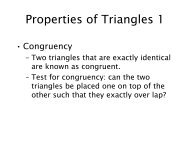

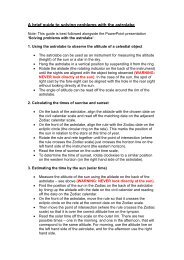
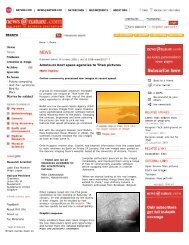
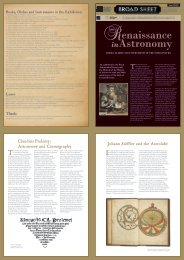
![Museum Guide and Plan [pdf] - Museum of the History of Science](https://img.yumpu.com/28054068/1/190x136/museum-guide-and-plan-pdf-museum-of-the-history-of-science.jpg?quality=85)
